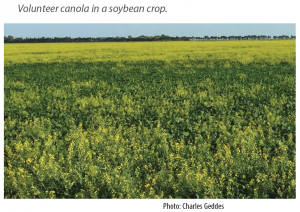This past July 2020, MPSG hosted a webinar featuring Dr. Charles Geddes, Research Scientist at Agriculture and Agri-Food Canada in Lethbridge. This webinar covered Dr. Geddes’ Manitoba-based research on volunteer canola management in soybeans and updates from his current research on how to mitigate and manage herbicide-resistant weeds in western Canada.
If you missed the webinar or you’re looking to verify a few facts, check out the key points below or find the recorded video at manitobapulse.ca.
Volunteer Canola Management in Soybeans
 Volunteer canola is the number one weed in soybeans in Manitoba. It has become a pest due to seed lot contamination, canola harvest loss (source of 4000–6000 seeds/m2), seedbank persistence (can last >3 years), short crop rotations, limited herbicide options and seed return from unmanaged volunteers.
Volunteer canola is the number one weed in soybeans in Manitoba. It has become a pest due to seed lot contamination, canola harvest loss (source of 4000–6000 seeds/m2), seedbank persistence (can last >3 years), short crop rotations, limited herbicide options and seed return from unmanaged volunteers.
Four different studies were conducted by Dr. Geddes and Dr. Rob Gulden at the University of Manitoba, testing different practices that might reduce volunteer canola populations in soybean crops and protect soybean yield.
Study 1 — Soil disturbance (timing and implement) after canola harvest to reduce volunteer canola persistence in the seedbank and reduce its population in subsequent crops
Tested early fall (September) vs. late fall (October) vs. spring (May) tillage and light (tine harrow) vs. heavy (tandem disc) disturbance.
- Early fall tillage lowered volunteer canola populations by half compared to other timings. It offered the best seedling recruitment ahead of winterkill. Spring tillage promoted volunteer canola emergence 3–4x more than other timings and would require control before planting.
- Low and high disturbance resulted in similar volunteer canola populations.
Study 2 — Management within the soybean crop (row spacing, plant population, inter-row tillage, soil N) to reduce volunteer canola and increase the competitive ability of soybeans
Tested 7.5″ vs. 15″ vs. 30″ rows, 160,000 pl/ ac (recommended) vs. 240,000 pl/ ac (1.5x the recommended rate), with vs. without inter-row tillage and residual soil nitrogen (N) level vs. N applied (20 lbs N/ ac) in separate trials.
- Row spacing did not influence soybean yield or the volunteer canola population.
- Soybeans seeded at the higher rate competed against volunteer canola and yielded well, but the canola population was not reduced.
- Inter-row tillage improved soybean yield (especially when the canola population was high) but did not reduce canola seed production because it also grew within seed-row.
- Soybean yields were unaffected by different N levels, but higher N resulted in more volunteer canola seed production.
- Each of these techniques used alone did not reduce volunteer canola seed production. However, integrating multiple practices may offer better results.
 Study 3 — Inter-seeded cereal mulch for early-season competition against volunteer canola
Study 3 — Inter-seeded cereal mulch for early-season competition against volunteer canola
Tested spring wheat mulch vs. fall rye mulch (both spring-seeded) vs. no mulch, 15″ vs. 30″ rows and two different herbicide regimes — group 1 to manage grassy weeds but let mulches remain living vs. standard post-emergence application of glyphosate to terminate the mulch.
- Soybean yields did not differ between the terminated mulch and those grown without mulch. The living mulch reduced soybean yield, but also reduced volunteer canola seed production by 1/4 to 1/3 — something that may show promise in combination with other practices.
Study 4 — Digging deeper into the effects of limited vs. abundant N on volunteer canola in a soybean crop
Tested 0, 20, 40, 80 and 160 lbs N/ ac and four different varieties of volunteer canola in soybeans vs. soybeans without volunteer canola.
- With volunteer canola present in the crop, volunteer canola seed production increased and soybean yield declined in response to increasing soil N levels. Without volunteer canola present, soybean yield remained stable with increasing N.
- These results confirm that the soil N level drives the competitive balance between N-fixing soybeans and non-leguminous weeds.
For more information on this research check out Pulse Beat – The Science Edition, Issue 2.
Mitigating Herbicide-Resistant Weeds in Soybeans
Canada currently ranks third worldwide for the most herbicide resistant (HR) weed species. The number of HR weed species has risen relatively quickly and is expected to continue increasing. Dr. Geddes’ current research is focused on increasing crop competitiveness and reducing selection pressure for resistance across western Canada.
One area of interest is glyphosate-resistant (GR) kochia. Weed surveys have shown GR kochia in Manitoba increased from 1% (2013) to 59% (2018) of the total kochia population in Manitoba, and from 5% (2012) to 50% (2017) in Alberta. Resistance to dicamba was also confirmed in 18% of the Alberta kochia population.
Four projects are ongoing across western Canada (including Manitoba sites hosted by Kristen MacMillan and Dr. Gulden), looking at several combinations of integrated weed management (IWM) practices to increase soybean competitiveness against weeds. IWM practices like variety selection, planting date, crop sequence, tillage system, row spacing, plant density and cover cropping, under both weedy vs. weed-free conditions.
A promising preliminary finding from one project is that high-yielding varieties under-weed free conditions also produced high yields under weedy conditions. This means breeders selecting varieties for high yield can know that they are also selecting varieties that are highly competitive against weeds. For the rest of the projects, it’s still too early to tell. Stay tuned.
